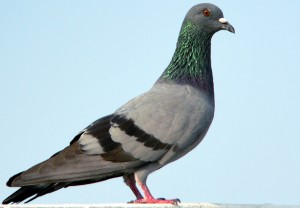(1)
MAKOVICKY, PETER J., and LINDSAY E. ZANNO. “Theropod Diversity and the Refinement of Avian Characteristics.” Living Dinosaurs: The Evolutionary History of Modern Birds. (2011): 9-25. Web. 25 Apr. 2013.
<http://www.academia.edu/543988/Theropod_diversity_and_the_refinement_of_avian_characteristics>.
(2)
Jetz, W., G.H. Thomas, J.B. Joy, K. Hartmann, and A.O. Mooers. “The global diversity of birds in space and time.” Nature. 491.7424 (2012): 444-48. Web. 25 Apr. 2013.
<http://www.nature.com/nature/journal/v491/n7424/full/nature11631.html>.
(3)
“PIGEONS – EVERYTHING THERE IS TO KNOW ABOUT THE PIGEON.” Independent Solutions for Pigeon Control Problems. Pigeon Control Resource Centre, n.d. Web. 01 Apr 2013. <http://www.pigeoncontrolresourcecentre.org/html/about-pigeons.html
(4)
Grzimek’s Animal Life Encyclopedia
Ed. Michael Hutchins, Arthur V. Evans, Jerome A. Jackson, Devra G. Kleiman, James B. Murphy, Dennis A. Thoney, et al. Vol. 9: Birds II. 2nd ed. Detroit: Gale, 2004. p241-246. COPYRIGHT 2003-2004 Gale, COPYRIGHT 2005 Gale, Cengage
(5)
Dawkins, Marian Stamp. an introduction to Animal Behaviour. 6th. New York: Cambridge University Press, 2012. 139, 229-231. Print.
(6)
“pigeon”. Encyclopædia Britannica. Encyclopædia Britannica Online.
Encyclopædia Britannica Inc., 2013. Web. 25 Apr. 2013
<http://www.britannica.com/EBchecked/topic/460131/pigeon>.
(7)
LiveScience, Staff. “Chickens See Color Better Than Humans.” LiveScience. (2010): n. page. Web. 25 Apr. 2013. <http://www.livescience.com/8099-chickens-color-humans.html>.
(8)
“Pigeon keeping.” Wikipedia. N.p., 26 Mar 2013. Web. 10 April 2013. <http://en.wikipedia.org/wiki/Pigeon_keeping>.
(9)
Social Problems
, Vol. 55, Issue 1, pp. 72–94, ISSN 0037-7791, electronic ISSN 1533-8533. © 2008 by Society for the Study of
Social Problems, Inc.
(10)
“Military Honours and Awards.” The National Archives. The Ministry of Defence. Web. 10 April 2013. <http://webarchive.nationalarchives.gov.uk/ /http://www.operations.mod.uk/honours/honours.htm>.
(11)
Konecki, Krzysztof T. “Animals and People.” Qualitative Sociology Review. Vol. 3.Issue 1 (2007): 79. Web. 25 Apr. 2013. <http://qsr.webd.pl/ENG/Volume6/QSR_3_1.pdf
(12)
“21 Amazing Facts You Didn’t Know About Pigeons.”deterapigeon. Pigeon Control Resource Centre. Web. 01 Apr 2013. <http://www.deterapigeon.com/21-amazing-facts-about-pigeons.htm>.
(13)
Hicks, Chris. “Technical History of Gunpowder Manufacture.” . N.p., n.d. Web. 05 Apr 2013. <http://cjhicks.orpheusweb.co.uk/gpdet.html>.
(14)
Murray, Patrick. “The Secret of Pigeon Poo.” Human Planet. BBC Earth, 7 Jul 2010. Web. 25 Apr 2013. <http://www.humanplanetblog.com/?p=1346>.
(15)
“Natural Selection: Charles Darwin and Alfred Russel Wallace.” Understanding Evolution. California State Berkley. Web. 25 Apr 2013. <http://evolution.berkeley.edu/evolibrary/article/history_14>
(16)
Montgomery, Stephen. “Pigeons and Variation.” Charles Darwin and Evolution. N.p., n.d. Web. 05 Apr 2013. <http://www.christs.cam.ac.uk/darwin200/pages/index.php?page_id=c6>.
(17)
Darwin, The Variation of Animals and Plants Under Domestication vol. 1 [91868) 1998]
(18)
“Pigeon Fanciers.” Pigeon Web: All you need to know about pigeons. WordPress, n.d. Web. 20 April 2013. <http://www.pigeonweb.net/pigeon-fanciers>.
